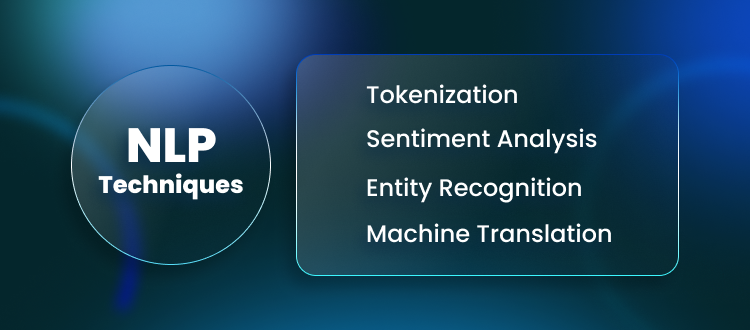 Have you ever asked Alexa to play your favorite song and wondered how it gets it right? Or noticed how chatbots seem to understand your questions like a real person would? These are just a couple of ways NLP and artificial intelligence make everyday interactions with technology feel more intuitive and human.
Have you ever asked Alexa to play your favorite song and wondered how it gets it right? Or noticed how chatbots seem to understand your questions like a real person would? These are just a couple of ways NLP and artificial intelligence make everyday interactions with technology feel more intuitive and human.
In this piece, you’ll learn about NLP, how it works generally, and its benefits. Let’s start!
What is NLP?
NLP is a branch of AI that enables computers and systems to read, understand, and derive meaning from human languages. It provides the most suitable response or output for our queries by using machine learning algorithms and linguistics to build models that break down and comprehend key details from text and speech.
Recent advancements in LLM technologies, such as GPT and BERT, have significantly enhanced NLP capabilities. These models process vast amounts of data to learn linguistic patterns and nuances, enabling more accurate and context-aware responses.
NLP is classified into Natural Language Understanding (NLU) and natural language generation (NLG). The former helps AI make sense of language, while the latter enables it to create responses. Both play important roles in seamless interactions between humans and machines.
NLP and Its Relationship to Human Language
Human language is diverse and complex, and different languages adhere to their own grammatical rules. NLP must account for these variables to understand and communicate with human languages.
According to a study, NLP enables machines to comprehend and analyze natural language by extracting concepts, entities, emotions, keywords, and more.
Here are some of the different approaches that tie NLP to human language:
Syntax
Syntax is all about how words fit together in sentences. While this might seem effortless for humans, it poses a real challenge for machines. The arrangement of words and their grammatical roles are vital for conveying meaning. For example, “The cat chased the dog” and “The dog chased the cat” use the exact words but tell different stories.
According to a study by Jasmin Praful Bharadiya, part-of-speech tagging is a critical task in NLP. In addition, NLP uses syntactic parsing to outline sentence structures. By grasping these grammar rules, NLP models can determine the roles of words in a sentence. This further enables them to break down complex sentences and extract meaningful insights.
Semantics
A word can have different meanings based on context. This is what happens in “hot dog,” which changes meaning when combined, unlike “hot” and “dog” on their own.
This can be tricky for NLP. Hence, its models use semantic analysis methods like word embeddings and vector representations. This approach works by turning words into numerical forms that capture their meanings in context.
For example, models like Word2Vec place similar words together, enabling the model to recognize relationships between “dog” and “puppy.” NLP models rely on context to find the correct meaning, needing to understand both the sentence and the correct interpretation of a sequence of words.
Context
Understanding isolated words is one thing. However, grasping language requires processing context, which can change a sentence’s meaning completely. For example, “He saw the man with a telescope” could mean either the observer had the telescope or the man did. NLP models can misinterpret sentences if they don’t consider these broader contexts.
This is where contextual models like the transformer used in GPT come into play. They track the relationships between words in a sentence, even over long distances. This allows the model to maintain context as it processes each word, for example, when the meaning of a word relies on something mentioned several sentences earlier.
Natural Language Processing Statistics
Over time, the NLP market has seen significant growth. This is especially true with the recent rise in the adoption of generative AI training programs. According to statistics by Market.us, the NLP market generated USD 27.9 billion in revenue and is projected to reach USD 47.8 billion by 2024.
NLP applications span various industries, such as healthcare, finance, retail, and customer service. The NLP statistics from Market.us also covered the market share distribution for NLP applications. Automatic summarization accounts for 18% of the total, and content management accounts for 17%.
Language Scoring comprises 15%, while Sentiment Analysis holds 17%. The remaining 23% goes to other applications.
Natural Language Processing Techniques

NLP uses several techniques to analyze and understand natural language. Here are some of the most common:
Tokenization
Tokenization is one of the first steps in NLP. It involves breaking down texts into tokens. These tokens can be words or phrases, depending on what you need to analyze. For instance, in the sentence “The boy jumps over the fence,” tokenization splits it into words: “The,” “boy,” “jumps,” “over,” “the,” and “fence.”
This process is key because it sets the foundation for identifying parts of speech and understanding context.
Sentiment Analysis
Sentiment analysis is a technique used to detect emotions in text. It helps systems determine if the sentiment is positive, negative, or neutral. Businesses often rely on it to analyze reviews and customer feedback. For example, the system would mark a review like “I absolutely love this product!” as positive, while comments of “This product is terrible!” would be negative.
Advanced sentiment analysis uses deep learning and Natural Language Understanding (NLU). This helps capture subtle emotions, sarcasm, or context-specific meanings to make analysis more accurate.
Entity Recognition
Entity recognition, or Named Entity Recognition (NER), is used in NLP to identify and classify specific entities in text. It classifies them as names, organizations, locations, and dates. This step extracts valuable information from unstructured data, making it easier to understand.
For instance, in the sentence “Apple Inc. announced the launch of something called the iPhone 15 on September 12, 2023,” NER would pick out “Apple Inc.” as a company, “iPhone 15” as a product, and “September 12, 2023” as a date.
Accurate entity recognition plays a vital role in information retrieval and data analytics. It is also needed for customer relationship management (CRM) and building knowledge graphs and documents.
Machine Translation
Machine translation automates the task of converting text from one language to another. With deep learning models and neural networks, translations have become more accurate. Unlike older systems, modern models like Google Translate learn from large multilingual datasets. This allows them to pick up the nuances of different languages.
For example, translating “I love reading books” into Spanish requires not only direct translation (“Me encanta leer libros”) but also an understanding of the grammatical structure. Recent updates include context-aware algorithms. These improve translations of idiomatic expressions and ensure text flows.
Common NLP Tools in Use

Several tools—both applications and libraries—are available to help you get started in NLP, including the following:
NLTK
NLTK (Natural Language Toolkit) is a Python library for processing and analyzing human language data. It gives you access to resources, including over 50 corpora and lexical tools. Also, it offers several pre-trained models.
NLTK supports several NLP tasks, such as tokenization, stemming, tagging, parsing, and semantic reasoning. It’s especially great for educational purposes and beginners in NLP, as it offers extensive documentation and tutorials that help you grasp the fundamental concepts of linguistics and language processing.
NLTK is also open source and available for Windows, Mac OS X, and Linux.
SpaCy
SpaCy is an open-source NLP library for Python that provides fast and efficient tools for industrial applications. Unlike NLTK, which serves a wide range of linguistic research, SpaCy focuses on performance and usability, making it ideal for production environments. SpaCY offers features like part-of-speech tagging, named entity recognition, dependency, and parsing.
GPT Models
Generative Pre-trained Transformer (GPT) models, like GPT-3, are cutting-edge language models by OpenAI. These models are for conversational AI and can generate human-like text based on input prompts. GPT-3, in particular, features an impressive 175 billion parameters.
This allows it to grasp context, produce coherent responses, and tackle various NLP tasks like translation.
The versatility and power of GPT models have made them popular in several applications. These include chatbots, virtual assistants, search engines, and content generation for social media.
How NLP Powers Conversational AI
As mentioned earlier, NLP is important in chatbots and virtual assistant applications. But how does this technology power those applications? Here’s a brief rundown of how NLP powers some conversational AI:
Chatbots
Chatbots, like ChatGPT and Claude, rely on NLP techniques to give human-like conversations. They use NLP for several key functions, which include:
- Understanding User Input: NLP helps chatbots analyze user queries by breaking down sentences. For instance, when a user asks, “What’s the weather like in New York?”, the chatbot recognizes the intent (weather inquiry) and the entity (New York).
- Generating Responses: With language generation models, chatbots can give coherent and relevant replies. They use pre-trained models like GPT to produce human-like text.
- Context Maintenance: This allows chatbots to keep track of context throughout a conversation. It enables them to manage multi-turn dialogues better. This capability is essential for providing relevant follow-up responses based on previous exchanges.
Virtual Assistants
Virtual assistants like Siri and Alexa use intelligence and NLP to improve user interactions and assist consumers with a variety of tasks:
- Voice Recognition: NLP is essential for converting spoken language into text. It enables virtual assistants to accurately understand user commands, whether they’re asking for directions or playing a favorite song.
- Task Management: These assistants analyze the meaning behind user requests to execute specific tasks. For instance, when a user says, “Set a reminder for my meeting at 3 PM,” the assistant interprets the command and schedules the reminder accordingly.
- Personalization: NLP enables virtual assistants to adapt to individual user preferences by analyzing past interactions and context. This capability allows them to offer tailored recommendations and responses.
Customer Service Automation
Here’s how NLP improves efficiency in customer experience
- Automated Responses: NLP enables businesses to use chatbots to handle common customer inquiries without human help. For instance, if a customer asks about their order status, the bot can quickly retrieve the information and respond accurately.
- Sentiment Analysis: NLP techniques analyze customer interactions to assess sentiment and emotional tone. This capability enables businesses to identify dissatisfied customers and take proactive measures.
- Data Extraction and Analysis: NLP tools can sift through large volumes of customer interactions to extract valuable insights. This data can then guide product development and service enhancements.
Industries Using Natural Language Processing
Several industries have adopted the use of NLP for various purposes. Here are some of the popular ones:
Healthcare
NLP simplifies patient record analysis, helping providers quickly mine training data to extract insights and improve care. It also personalizes treatments by spotting trends in large datasets.
Finance
NLP helps detect fraud by analyzing transaction patterns and flagging suspicious activities. It also improves customer service, enabling chatbots to handle inquiries quickly.
Retail
NLP personalizes shopping experiences by analyzing customer preferences, leading to better product recommendations. This helps businesses understand their customers and boost satisfaction.
Customer Support
NLP-powered chatbots provide instant help with common questions, freeing up human agents for more complex tasks. Analyzing customer interactions also helps companies improve their products and services.
NLP Programming Languages
Several programming languages are widely used for natural language processing, and here are the top choices:
Python
Python is one of the most popular languages for (NLP and it’s easy to see why. It’s simple, versatile, and comes with powerful libraries like NLTK, SpaCy, and Hugging Face’s Transformers. These tools make it easy to work with text, from basic tasks like tokenizing words to advanced deep learning with language models.
R
R is known for its strength in statistical computing, but it’s also widely used for natural language analysis. Libraries like tm, text, and quanteda make text analysis easy. They are great for statistical models and exploratory data analysis. While Python is more mainstream for NLP, R is a go-to for data scientists and researchers who want to analyze language in detail.
Java
Java is common in NLP for enterprise environments where scalability and performance matter most. It supports large-scale, real-time processing with libraries like Stanford NLP and Apache OpenNLP. Java’s speed and ability to handle large datasets make it ideal for complex, scalable NLP solutions in finance and healthcare.
How Does NLP Technology Play into Conversational AI and More?
Conversational AI
NLP is the backbone of conversational AI, making chatbots and virtual assistants like Siri or Alexa sound more human. It helps these systems understand what you’re saying, figure out what you mean, and respond in a way that feels natural.
Gone are the days of chatbots only picking up on keywords—thanks to NLP, they can now get the context, pick up on your intent, and even recognize emotions. That’s why asking your virtual assistant questions feels like a real conversation, a human communication, not just a robotic exchange.
Image Generation
When you describe something in words, and an AI tool turns it into an image, NLP works behind the scenes. Tools like DALL-E use NLP to “read” your text prompt and understand the visual you’re imagining.
NLP acts as the bridge between language and art, translating your words into detailed, creative images. It connects your ideas to the AI’s ability to bring them to life visually, turning your descriptions into pictures with precision.
Speech Recognition
NLP powers speech recognition, enabling your devices to turn spoken words into text. It’s what makes voice commands and interactions with smart devices possible. Whether texting by voice or asking your smart speaker to play a song, NLP ensures these interactions run smoothly.
NLP breaks down spoken language so the AI can understand your requests. This lets you control your technology with just your voice.
Advantages and Challenges of NLP
Like any system, NLP has its advantages and disadvantages.
Pros
- Handling Large Data Sets: NLP is a game-changer when managing vast amounts of text. It can process and analyze tons of data quickly, saving you time and effort. With NLP, you can pull insights faster and make decisions without drowning in manual work.
- Smart Automation: NLP also boosts automation by letting systems read and respond to text without needing humans. Think chatbots answering questions or email filters sorting your inbox. Plus, it helps personalize experiences, like customizing real-time responses based on user needs. This makes everything more efficient and user-friendly.
Cons
- Trouble with Context: Even though NLP is smart, it sometimes finds it hard to understand context. Things like sarcasm, idioms, or double meanings can throw it off. So, while it’s great for general tasks, it might miss the mark in complex language.
- Cultural Nuance Issues: NLP also struggles with cultural nuances. What works in one language or region might not make sense in another. So, models that aren’t trained on diverse data can misinterpret slang or tone. This can lead to mistakes, especially in global applications where context is key.
FAQs on Natural Language Generation
What Is NLP in Natural Language Processing?
NLP, or Natural Language Processing, helps computers understand human language. It combines linguistics, computer science, and machine learning to process and analyze text or speech. NLP makes it possible for chatbots to understand us and respond in a more human-like way.
What Are the 5 Steps in NLP?
The five main steps in NLP are:
- Tokenization – breaking text into words or sentences.
- Parsing – analyzing sentence structure.
- Stemming – cutting words down to their root form.
- Named Entity Recognition (NER) – identifying names, places, or things.
- Sentiment Analysis – determining if the text is positive, negative, or neutral.
What Can NLP Be Used For?
NLP has many applications, such as:
- Powering chatbots to assist customers.
- Analyzing patient records in healthcare.
- Recommending products in e-commerce.
- Tracking trends through sentiment analysis.
Is ChatGPT an NLP?
Yes, ChatGPT is an example of NLP in action. It uses advanced language models to understand and generate human-like responses, allowing it to chat about many topics and answer questions naturally.
How Is Natural Language Processing (NLP) Related to NSFW Content?
NLP techniques are employed to detect and filter NSFW AI content in text. This includes identifying inappropriate language, including AI sexting, comments, or descriptions that may be harmful or offensive. Machine learning models, such as those using logistic regression or support vector machines, are often trained on datasets containing both safe and unsafe text to improve classification accuracy.
Conclusion on Natural Language Understanding
NLP plays a significant role in modern AI. It helps machines understand and interact with human language. Tools like virtual assistants and chatbots rely on it to make our interactions with technology feel natural.
NLP has also changed industries like healthcare, finance, and e-commerce. It helps analyze patient records, detect fraud, and personalize shopping experiences. By improving efficiency, it is enabling businesses to connect with customers more efficiently.
However, there are still challenges commonly associated with NLP. It is recommended that outputs be always cross-referenced, especially in sensitive topics.
As NLP improves, we will see more natural, human-like interactions with technology. The future offers exciting possibilities for further research and applications in AI communication.






















